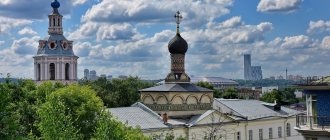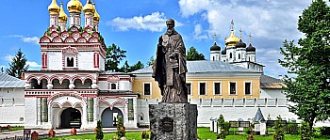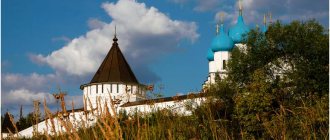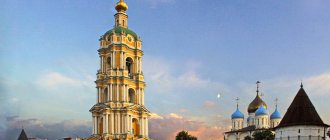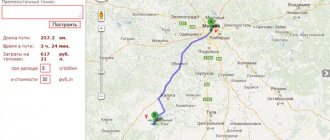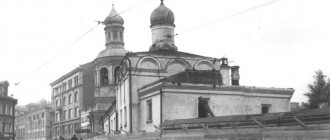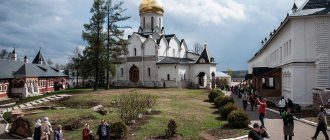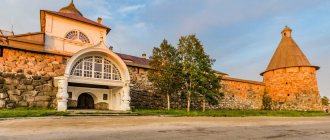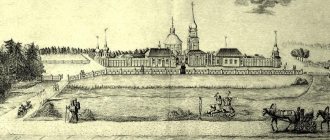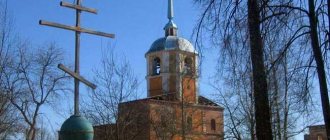Zaikonospassky Monastery . Starting from the 14th century, in this place, on Nikolskaya Street, there was a monastery of St. Nicholas the Old, the full name of which sounded like “Spassky Monastery on St. Nicholas Krestets, on Sands, on the Old Place.”
Researchers suggest that the current monastery, which was located behind the icon row (shops selling icons), was founded in 1600 by Boris Godunov himself. The image of the religious institution in the “Sigismund Plan of the City of Moscow”, in confirmation of this, suggests that it was already here before 1610.
True, the first documentary mention of the monastery dates back to 1635, which is indicated in the books of the Moscow Patriarchal Prikaz.
History of the Zaikonospassky Monastery
In 1660, during the reign of autocrat Alexei Mikhailovich, the first stone was laid on the territory of the Zaikonospassky Monastery for the construction of a two-story stone Spassky Cathedral. On the first level they placed a temple in the name of the icon of the Savior, the Image Not Made by Hands, and on the second level - in the name of the holy icon of the Mother of God of the Joy of All Who Sorrow.
The governor, Prince Fyodor Fedorovich Volkonsky, allocated funds for the charitable cause. Construction was completed in 1661 on November 20.
In 1665, Simeon of Polotsk became the abbot of the monastery. It was under him that a school appeared here, in which clerks were trained for the royal office of the “Order of Secret Affairs.” From the moment the school was founded, the corresponding definition began to be added to the name of the Zaikonospassky Monastery - “teacher’s”.
The first attempt to create a Slavic-Greek-Latin Academy within the walls of the monastery came in 1680. The then rector Sylvester Medvedev, who, by the way, graduated from the local school, submitted a petition to Tsar Fyodor Alekseevich, but due to the death of the latter, the plan could not be realized then.
In 1687, the Hellenic-Greek (Spasskaya) school, founded by the Likhud brothers back in 1685, was moved here from the Epiphany Monastery, which was the first higher educational institution in the lands of Muscovy. After a while, it was merged with the Moscow Typographical School and received the status of the Slavic-Greek-Latin Academy.
The rectors of the Academy were local abbots and archimandrites of the Zaikonospassky Monastery, whose churches and service buildings were given over to the educational and religious needs of the students.
The fires of 1701 and 1737 required the rebuilding and reconstruction of churches and monastery buildings. Famous architects were involved in the work, including Ivan Petrovich Zarudny, Ivan Fedorovich Michurin, Mikhail Timofeevich Preobrazhensky and Zinovy Ivanovich Ivanov.
The local Academy moved to the Trinity-Sergius Lavra in 1814 and was renamed the Moscow Theological Academy, and a theological school was located in its place.
The Assumption Cathedral appeared on the territory of the Zaikonospassky Monastery in 1825. The author of the project was the architect Semyon Pavlovich Obitaev.
Zaikonospassky stavropegial monastery Stavropegial monasteries of the Russian Orthodox Church
Under the first abbot of the Zaikonospasskaya monastery, Macarius (1630s), a national school was opened here. In it, under the leadership of Arseny the Greek, for the first time in Russia they began to study Latin and Greek. By the middle of the 17th century, a special building for a “school for grammatical teaching” was being built in the monastery, and the epithet “educational” was added to the name of the monastery. Specially invited educated Kyiv monks who made up the learned brotherhood come here from the Moscow St. Andrew's Monastery.
Since 1665, a school (headed by Simeon of Polotsk) operated in the Zaikonospassky Monastery, which trained officials for government agencies. Finally, in 1687, the first Russian all-class higher educational institution, the Slavic-Greek-Latin Academy, moved into the monastery, headed by Greek scholar-monks, brothers Ioannikis and Sophronius Likhud. The Academy existed within the walls of the monastery until 1814. Among its graduates are many prominent figures of the Church, scientists and writers. The academy also trained educated priests.
In 1701, a new double-altar cathedral was built in the monastery, which became one of the best monuments of Peter the Great's Baroque. It was erected by the talented architect Ivan Zarudny, who built the Menshikov Tower and the Church of St. John the Warrior on Bolshaya Yakimanka in Moscow. Then the Spassky Cathedral acquired its modern appearance: a tall octagon on a quadrangle, walkways with observation decks, and strict orderly decorative elements.
The architectural ensemble of the monastery took shape until the beginning of the twentieth century. The Spassky Cathedral was badly damaged during the fire of 1737 and was, by personal order of Empress Elizabeth Petrovna, restored by I.F. Michurin. The upper church was consecrated in 1742 in honor of the icon of the Mother of God “Joy of All Who Sorrow.” The following year, a bell tower appeared above the Holy Gates. A century later, in 1851, the dome of the cathedral was crowned with an elegant onion-shaped dome-rotunda.
The cathedral kept a copy of the miraculous Vladimir Icon of the Mother of God in a Golden Robe, donated by Count N.P. Sheremetev. On the feast of the Vladimir Icon on May 21/June 3, a religious procession was held here from the Assumption Cathedral of the Kremlin in memory of the deliverance of Moscow from the invasion of the Crimean Khan Makhmet-Girey in 1521.
Outstanding church figures emerged from the walls of the Zaikonospasskaya monastery. One of them is Augustine (Vinogradsky), Archbishop of Moscow and Kolomna - rector of the academy and abbot of the monastery in 1801–1804. He was called “Chrysostom of the twelfth year” for his patriotic sermons during Napoleon’s invasion. He also composed a special prayer “in the invasion of the adversary,” which sounded in churches during the Liturgy and at the prayer service on the Borodino field before the battle; Vladyka supervised the removal of Moscow shrines to Vologda, and at the hour of the Battle of Borodino, with miraculous icons, he walked around the walls of Moscow in a procession of the cross.
During the War of 1812, the monastery was severely destroyed. Soon it was decided to transform the first Russian university into the Moscow Theological Academy and transfer it to the Trinity-Sergius Lavra.
For some time, the Zaikonospassky Monastery housed the Moscow Theological Seminary, and since 1834, the Moscow Theological Zaikonospassky School, where the holy righteous Alexy of Moscow (Archpriest Alexy Mechev) studied. A considerable number of graduates of the school are now canonized as holy new martyrs and confessors of Russia.
With the advent of Soviet power, the monastery cathedral was captured by renovationists for several years. In 1929, the monastery was closed and housed various government agencies. In the 1960s, the cathedral building was restored.
The Cathedral of the Savior Not Made by Hands was returned to the Church in 1992 and received the status of the Patriarchal Metochion. In February 1993, the Russian Orthodox University opened in the monastery, but due to the disrepair of the cathedral and lack of premises, it was moved to the Vysoko-Petrovsky Monastery.
On March 5, 2010, at a meeting of the Holy Synod, it was decided: “To bless the opening of the Zaikonospassky stauropegial monastery in Moscow, separating it from the Patriarchal metochion of the former Zaikonospassky and Nikolsky monasteries in Kitai-Gorod.” Abbot Peter (Afanasyev) was appointed abbot of the monastery. A talented musician, regent, founder of the male chamber choir “Blagozvonnitsa”, Abbot Peter, having taken monastic vows, cared, in addition to his monastery, two sister communities, from which the stauropegic women’s monasteries in Akatovo and Shostya subsequently grew.
Zaikonospasskaya monastery after the revolution and today
In 1922, the Spassky Cathedral of the monastery, which by that time had already been abolished by the Bolsheviks, became the center of the renovationist so-called “Union of Church Revival,” but already in 1929 it was closed, after which state institutions were located here.
In the 60s of the last century, the main temple of the Zaikonospasskaya monastery was restored and somewhat modified. So, lucarnes were installed on the roof of the church, and a decorative fence was installed on two tiers - the third and fourth. At the same time, instead of a cross, a gilded pin appeared on the dome.
The Spassky Church returned to the fold of the Russian Orthodox Church at the beginning of 1992, and already in July the first service was held here. The monastery itself was revived after a meeting of the Holy Synod, held in 2010 on March 5.
Zaikonospassky Monastery is located at the address: Moscow, Nikolskaya, 7-9, Teatralnaya metro station.
Cradle of Russian education
The monastery, which was initially called the Monastery of the Most Merciful Savior on the St. Nicholas Cross behind the Icon Row, was founded by Tsar Boris Godunov himself. And although the monastery was first mentioned in documents only in 1635, the date of its foundation is considered to be 1600. And the notorious clarification about the location of the monastery behind the rows in which they sold folding objects and icons served to transform the name of the church institution into the Zaikonospassky Monastery.
At first, the authority and position of the newly created monastery were very modest, but over time the Zaikonospassky Monastery became the center and cradle of Russian enlightenment.
In the mid-60s of the 17th century, Simeon of Polotsk established a school for clerks of the Order of Secret Affairs in the monastery, and already in 1687 the Slavic-Greek-Latin Academy settled here. It is considered the first higher educational institution in Great Russia. The academy's graduates included the great Russian scientist M. Lomonosov, Kamchatka explorer S. Krasheninnikov, architect V. Bazhenov, poet V. Trediakovsky, and founder of the Russian theater F. Volkov.
With the opening of Moscow University, the Academy was transformed exclusively into a theological educational institution that trained clergy. At the beginning of the 19th century, it was renamed, became known as the Moscow Theological Academy and was relocated to the walls of the Trinity-Sergius Lavra, and a theological school was opened in the Zaikonospassky Monastery.
LiveInternetLiveInternet
Quote from Leonsija
Read in full In your quotation book or community!
Nikolskaya Street in Moscow is the busiest and perhaps most popular street among Muscovites. In the 12th century there was a road from Rostov the Great, Suzdal and Vladimir to the Kremlin. And it is not surprising that it was chosen by merchants and several famous Moscow monasteries arose along it. One of these is the male, 2nd class, non-social Bogoyavlensky behind Torg or behind Vetoshny Row. It is located between Nikolskaya and Ilyinka streets in Bogoyavlensky Lane.
From the collection of Naydenov N.A. Epiphany Cathedral in the Moscow Epiphany Monastery, 1883
The history of the appearance of the monastery goes far back to the times of Prince of Moscow Daniil Alexandrovich, son of Alexander Nevsky. The year the monastery was founded was 1292. At this time, the western part of the monastery adjoined Red Square with trading tents and rows. The northern part bordered on the road to Rostov Veliky, Suzdal and Vladimir. All buildings were made of wood, the first stone structure, the Church of the Epiphany, was built in 1342 under the leadership of the boyar Protasius. Thus, the Epiphany Monastery is one of the oldest monasteries in Moscow.
View of the Zaikonospassky and Epiphany monasteries in 1917 from Teatralnaya Square
One of its first abbots was Stefan, brother of St. Sergius of Radonezh. Saint Alexy, the future Metropolitan of Moscow, took monastic vows in the monastery in 1312. He spent 27 years in this monastery. The monastery was devastated by the conqueror many times, was plundered, but was revived each time. So in 1451, the monastery was not only plundered by the Tatars, but also burned. By order of Prince Vasily the Dark, it was restored, but already in 1547 it burned again as a result of the famous Vozdvizhensky fire.
In 1624, a new stone cathedral with the Church of the Kazan Mother of God was built in the monastery on the site of the strictly Church of the Epiphany. There were two gates in the monastery: one for the “strict” half, where women were prohibited from entering, and the second “common” - a gate for everyone. Both halves were also separated by a fence placed from north to south. At the end of the 17th century, stone fraternal cells were built and at the same time the cathedral was rebuilt and, as the chronicler writes, “in the summer of 7021 (1693) this temple and the name of the Epiphany of the Lord God and our Savior Jesus Christ was created, under the power of the Great Sovereigns and Grand Dukes John Alekseevich and Peter Alekseevich in the month of January on the 20th day.”
Modern view of the Epiphany Cathedral
The cathedral is one of the brightest examples of the “Naryshkin” or Moscow baroque - a style that came into fashion in Moscow at the end of the 17th century. On a high basement. Wall cornices with double windows. The window frames of the octagonal drum of the chapter are decorated with several tiers of white stone details. Rich white stone decoration - torn pediments, hermetic pilasters, shells, lush cornices with hanging consoles in the form of a fringe, an abundance of decorative balusters inserted into the platbands, cornices and columns at the corners of the octagonal drum. Contributions to the decoration of the monastery and its cathedral were made by the boyars Yusupov, Golitsyn, Dolgorukov, Sheremetev, Shcherbakov and many others.
Fragments of the external decor of the Epiphany Monastery
Inside the cathedral, the alabaster sculptural decoration was made by a team of Italian craftsmen under the leadership of D. M. Fontana. Numerous tombstones are inserted into the wall, including works by the famous French sculptor J. A. Houdon, now stored in the Scientific Research Museum of Architecture named after A. V. Shchusev. In 1739, a bell tower was erected over the now disappeared internal gates, and in 1747, 1749 and 1754 the cathedral acquired three chapels and a bell tower. The monastery buildings were preserved during the reconstruction of the 1870-1880s. Already from the end of the 18th century, the monastery began to give in to the trade spirit of Kitay-Gorod. At first, in its buildings stretched along the street and alley, solid haberdashery shops appeared. In 1905, the gate bell tower and corner buildings of the monastery property were broken. In 1910, the Monastery Trading House was built (Nikolskaya St., 6). The pre-revolutionary staff of the monastery consisted of 14 monks, 18 novices and an abbot. The glory of the monastery had already faded by that time, and the monastic lands were greatly reduced by trade.
Epiphany Cathedral in the Moscow Epiphany Monastery. Early 20th century
From the first days of its existence, the monastery began to form its own necropolis. The father of Metropolitan Alexei, boyar Fyodor Byakonta, was buried here in the lower tier of the Church of the Kazan Mother of God. Prince G.D. Yusupov, an associate of Peter I, was buried in the basement. The lower part of the cathedral became the family tomb of the Golitsyns and over many of the graves there were sculptures of J.-A. Gudon (they can now be seen on the territory of the Donskoy Monastery in a separate room under the roof). Here was also the burial place of Prince A.A. Menshikov, who died on November 27, 1764 at the age of 51 after returning from exile to Berezov. There were also burial places of the princes Saltykov, Skavronsky, Yusupov and other famous families of Russia. Some of the graves have survived to this day, but the main part was destroyed in 1930.
Fragments of the appearance of the Epiphany Cathedral
After 1917 the monastery was closed. In the early 1920s, the Athos Chapel and the monastery premises overlooking Nikolskaya Street were demolished. The cathedral was closed in July 1929 and was used as a dormitory, warehouse, production workshop, and printing house. The temple was beheaded, the buildings decayed and crumbled before our eyes.
In 1991, the Epiphany Cathedral was returned to the Russian Orthodox Church, the lower church with the throne of the Kazan Icon of the Mother of God and the chapel of St. Alexy, Metropolitan of Moscow, was consecrated, in 1998 - the upper one with the main altar of the Epiphany and the side altar of the Hieromartyr Vladimir, Metropolitan of Kyiv.
Monument to the Likhud brothers
And one more thing: on this land during the 1680-1687s, in other words, under the princess - ruler Sophia Alekseevna, there was a school of the brothers Ioannikis and Sophronius Likhudov, which, after being transferred to the Zaikonospassky Monastery, joined the Slavic-Greek-Latin Academy. They taught all subjects, they also compiled textbooks. The Likhud brothers were one of the few Greeks who linked their fate with Moscow. Most of the Greeks who came were clergymen who collected alms in Russia for the needs of their churches and monasteries. In memory of them, a monument by sculptor Vyacheslav Klykov was erected in front of the Epiphany Church. And the journey along Nikolskaya Street will continue further...
